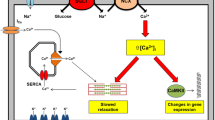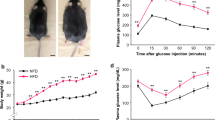Abstract
Among the last consequences of metabolic syndrome are cardiovascular complications such as infarcts. The hypoxic heart switches its lipid-based metabolism to carbohydrates, and a glucose-insulin-potassium (GIK) solution can be the metabolic support to protect the organ. Due to the physiology and cardiac risks associated with the metabolic syndrome, we studied the effect of GIK solution during hypoxia in a metabolic syndrome model by observing the participation of glucose transporters (GLUTs). The metabolic syndrome characteristics were established by giving a 30% sucrose drinking solution to Wistar rats for 24 weeks. The GIK solution’s effect on myocyte glucose uptake during hypoxia and oxygenation was observed using a colorimetric method, and Western blot technique visualized the GLUT participation. Oxygenated control myocytes consumed 1.7 ± 0.2 µg of glucose per gram of fresh tissue per hour using the GLUT1, and during hypoxia, they incorporated 41.1% more glucose by GLUT1 and GLUT4. The GIK solution improved glucose uptake in oxygenation by 70.5% through GLUT1. In hypoxia, the uptake was 21% more than the hypoxic control group and by both GLUTs too. Oxygenated metabolic syndrome myocytes uptake was similar to control cells but achieved by both carriers in oxygenation and hypoxia. Also, the GIK solution had a better response in both oxygenation (113%) and hypoxia (71%). Despite the metabolic energy disorders of this syndrome, the GIK solution protects cardiomyocytes, in conditions of hypoxia, through the modulation of both GLUTs. So, this solution can be considered a useful resource during a heart attack in cases of metabolic syndrome.



Similar content being viewed by others
Abbreviations
- GIK:
-
glucose-insulin-potassium
- GLUT:
-
glucose transporters
- HOMA:
-
homeostasis model assessment
References
Antunes LC, Elkfury JL, Jornada MN, Foletto KC and Bertoluci MC 2016 Validation of HOMA-IR in a model of insulin resistance induced by a high-fat diet in Wistar rats. Arch. Endocrinol. Metab. 60 138–142
Balen D, Ljubojević M, Breljak D, Brzica H, Žlender V, Koepsell H and Sabolić I 2008 Revised immunolocalization of the Na_-D-glucose cotransporter SGLT1 in rat organs with an improved antibody. Am. J. Physiol. Cell. Physiol. 295 C475–C489
Carbó R, Nava P and Guarner V 2003 Effects of polarizing solution on glucose uptake of rat oxygenated or hypoxic ventricular myocytes. Clin. Exp. Pharmacol. Physiol. 30 64–71
Castellanos-Jankeiwicz AK, Rodríguez-Peredo SM, Cardoso-Saldaña G, Díaz-Díaz E, Tejero-Barrera ME, del Bosque-Plata L and Carbó R 2015 Adipose tissue redistribution caused by an early consumption of a high sucrose diet in a rat model. Nutr. Hosp. 31 2546–2553
Ellenberger C, Sologashvili T, Kreienbühl L, Cikirikcioglu M, Diaper J and Licker M 2018 Myocardial protection by glucose–insulin–potassium in moderate- to high-risk patients undergoing elective on-pump cardiac surgery: a randomized controlled trial. Anesth. Analg. 126 1133–1141
Essop MF 2007 Cardiac metabolic adaptations in response to chronic hypoxia. J. Physiol. 584 715–726
Flores-Chávez PL, Infante-Vázquez O, Sánchez-Torres G, Martínez-Memije R and Rodríguez-Rossini G 2002 Detección de signos vitales en ratas mediante métodos no invasivos. Vet. Mex. 33 179–187
Heather LC, Pates KM, Atherton HJ, Cole MA, Ball DR, Evans RD, Glatz JF and Luiken JJ 2013 Differential translocation of the fatty acid transporter, FAT/CD36, and the glucose transporter, GLUT4, coordinates changes in cardiac substrate metabolism during ischemia and reperfusion. Circ. Heart Fail. 6 1058–1066
Lab Diet-Standard Diets (http://www.labdiet.com/Products/StandardDiets/)
Lau DCW, Yan H and Dhillon B 2006 Metabolic syndrome: a marker of patients at high cardiovascular risk. Can. J. Cardiol. 22 Suppl B 85B–90B
Lee WS, Kanai Y, Wells RG and Hediger MA 1994 The high affinity Na+/Glucose cotransporter. J. Biol. Chem. 269 12032–12039
Lowry OH, Rosenbrough NJ, Farr AL and Randall RJ 1951 Protein measurement with folin-phenol reagent. J. Biol.Chem. 193 265–275
National Center for Health Statistics, Division of Health Interview Statistics. Crude and age-adjusted percentage of civilian, noninstitutionalized adults with diagnosed diabetes, United States, 1980–2010. National Center for Chronic Disease Prevention and Health Promotion, Ed. Atlanta, GA, Centers for Disease Control and Prevention, Division of Diabetes Translation, 2012
Ramasamy R, Hwang YC, Whang J, Bergmann SR and Schaefer S 2001 Protection of ischemic hearts by high glucose is mediated in part by Glut-4. Am. J. Physiol. 281 H290–H297
Reaven GM and Ho H 1991 Sugar-induced hypertension in Sprague-Dawley rats. Am. J. Hypertens. 4 610–614
Rosenblatt-Velin N, Montessuit C, Papageorgiou I, Terrand J and Lerch R 2001 Post-infarction heart failure in rats is associated with upregulation of GLUT-1 and downregulation of genes of fatty acid metabolism. Cardiovasc. Res. 52 407–416
Scheepers A, Joost HG and Schurmann A 2004 The glucose transporter families SGLT and GLUT: molecular basis of normal and aberrant function. J. Parenter. Enteral Nutr. 28 Suppl 5 364–371
Shanahan MF 1982 Cytochalasin B: a natural photoaffinity ligand for labeling the human erythrocyte glucose transporter. J. Biol. Chem. 257 7290–7293
Shao D and Tian R 2015 Glucose transporters in cardiac metabolism and hypertrophy. Compr. Physiol. 6 331–351
Saklayen MG 2018 The global epidemic of the metabolic syndrome. Curr. Hypertens. Rep. 20 6–8
Sodi-Pallares D, Bisteni A, Medrano GA, Testelli MR and De Micheli A 1963 The polarizing treatment of acute myocardial infarction. Possibility of its use in other cardiovascular conditions. Dis. Chest. 43 424–432
Szablewski L 2017 Glucose transporters in healthy heart and in cardiac disease. Int. J. Cardiol. 230 70–75. https://doi.org/10.1016/j.ijcard.2016.12.083
Thwaites DT and Anderson CMH 2007 H+-coupled nutrient, micronutrient and drug transporters in the mammalian small intestine. Exp. Physiol. 92 603–619
Trinder P 1969 Determination of glucose in blood using glucose oxidase with an alternative oxygen acceptor. Ann. Clin. Biochem. 6 24–30
Zhou L, Cryan EV, D’Andrea MR, Belkowski S, Conway BR and Demarest KT 2003 Human cardiomyocytes express high level of Na+ /glucose cotransporter 1 (SGLT1). J. Cell. Biochem. 90 339–346
Author information
Authors and Affiliations
Corresponding author
Additional information
Corresponding editor: María Luz Cárdenas
Rights and permissions
About this article
Cite this article
Carbó, R., Rodríguez, E. A glucose-insulin-potassium solution improves glucose intake in hypoxic cardiomyocytes by a differential expression of glucose transporters in a metabolic syndrome model. J Biosci 44, 19 (2019). https://doi.org/10.1007/s12038-018-9833-7
Received:
Accepted:
Published:
DOI: https://doi.org/10.1007/s12038-018-9833-7




